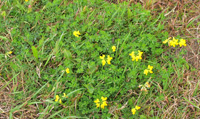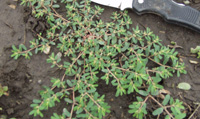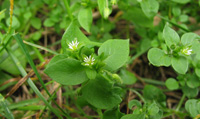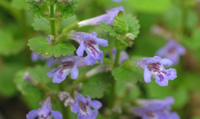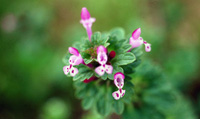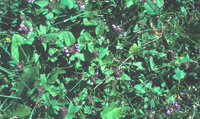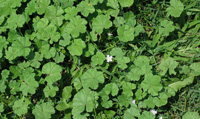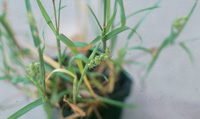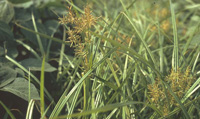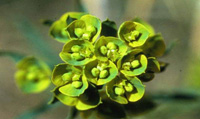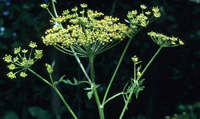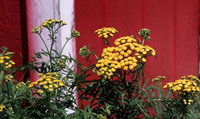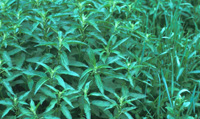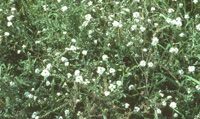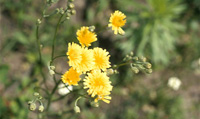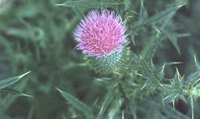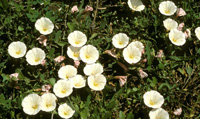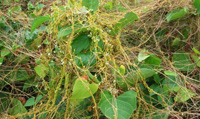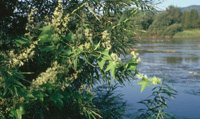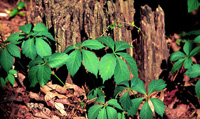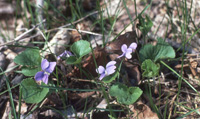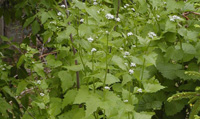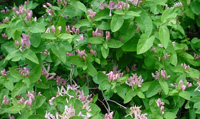Extension > Garden > Diagnose a problem > Is this plant a weed? > Control options for weeds
Control options for common Minnesota lawn and landscape weeds
The following provides both cultural and chemical control options for common weeds found in Minnesota lawns and landscapes. Cultural control options can be used in any type of garden, lawn or landscape. Chemical control options can ONLY be used at the locations listed directly on the label of the product. Prior to purchasing and applying any herbicide, completely read the product label and follow all instructions. Select a product that specifies use at the desired treatment location (e.g. lawn, flower garden etc). It is illegal to use an herbicide in a manner not listed on its label.
In addition, using an herbicide labeled for use on lawns in a flower or vegetable garden will likely prove injurious or even fatal to the desired plants. For example, a selective, post-emergence weed control product designed to control dandelions, clover and other broadleaf weeds in a lawn without harming the lawn will not be labeled for, and cannot be used in, vegetable or flower gardens. Doing so will result in the very high probability that those 'broadleaf' flower and vegetable plants will be injured or killed as well. Indeed, it may even result in the loss of that garden space due to contaminated soils for at least the remainder of the current growing season. Hence, it is ALWAYS important to select appropriately labeled weed killers for use in specific sites (e.g., lawns, flower gardens, etc.) and that will not injure the surrounding desirable plants.
On this page
Creeping, spreading, mat-forming weeds:
- Black Medic
- White Clover
- Birdsfoot Trefoil
- Yellow Woodsorrel
- Prostrate Knotweed
- Prostrate Spurge
- Common Purslane
- Common Chickweed
- Mouse-ear Chickweed
- Ground Ivy, Creeping Charlie
- Henbit
- Heal-all
- Common Mallow
- Creeping Bellflower
- Creeping Yellowcress
Grasses:
- Large Crabgrass, Smooth Crabgrass
- Foxtail - Yellow, Green, and Giant
- Barnyardgrass
- Longspine Sandbur
- Creeping Bentgrass
- Quackgrass
- Tall Fescue
- Rough Bluegrass
- Reed Canarygrass
Sedges:
Upright weeds:
- Hemp
- Purple Loosestrife
- Leafy Spurge
- Wild Parsnip
- Oxeye Daisy
- Tansy
- Stinging Nettle
- Hoary Alyssum
- Perennial Sowthistle
- Bull Thistle
- Canada Thistle
- Musk Thistle
- Plumeless Thistle
- Common Burdock
Vining weeds:
Basal weeds:
- Broadleaf Plantain
- Dandelion
- Common Blue Violet
- Garlic Mustard
- Spotted Knapweed
- Perennial Sowthistle
Woody weeds:
Creeping, Spreading, and Mat-forming
-
Black Medic (Medicago lupulina)
Most Common Location:
Lawns, landscape plantings
Cultural Control Options:
Hand pulling; maintain adequate lawn nitrogen level
Chemical Control Strategies*:
Preemergence Lawns: 1
Non-lawn: 3Postemergence
Lawns: 4
Non-lawn: 11, 13Additional Weed Control Information:
The herbicide dithiopyr will provide some preemergence control in lawns.
Best time to apply postemergent broadleaf herbicides is early in the season when plants are small; repeat application may be needed for best control.
-
White Clover (Trifolium repens)
Most Common Location:
Lawns, landscape plantings
Cultural Control Options:
Small patches can be removed by hand being careful to get all rooted plantlets; maintain adequate lawn nitrogen levels.
Chemical Control Strategies*:
Postemergence
Lawns: 5
Non-lawn: 11, 13Additional Weed Control Information:
Products containing MCPP and/or triclopyr usually provide better results.
Birdsfoot Trefoil (Lotus corniculatus)
Most Common Location:
Lawns, landscape plantings, boulevards
Cultural Control Options:
Small patches and/or individual plants can be hand pulled; maintain adequate lawn nitrogen levels
Chemical Control Strategies*:
Postemergence
Lawns: 6
Non-lawn: 11, 13Additional Weed Control Information:
Tolerates low mowing heights, poor growing conditions including drought and high salt contents.
Yellow Woodsorrel (Oxalis stricta)
Most Common Location:
Lawns, landscape plantings
Cultural Control Options:
Hand pulling; get roots and rhizomes as they can grow new plants; in lawns encourage vigorous healthy grass growth.
Chemical Control Strategies*:
Preemergence Lawns: 1
Non-lawn: 3
Postemergence
Lawns: 4
Non-lawn: 11, 13Additional Weed Control Information:
Products containing 2,4-D + 2,4-DP or triclopyr usually provide better results.
Post emergent herbicide applications are best done during daylight hours as leaves fold downward toward evening making it very difficult to get herbicide to stick onto the foliage.Prostrate Knotweed (Polygonum aviculare)
Most Common Location:
Lawns, landscape plantings
Cultural Control Options:
Hand removal with limited number of plants; relieve soil compaction (aerate, i.e. core aeration) as it is well adapted to those conditions.
Chemical Control Strategies*:
Preemergence Lawns: 1
Non-lawn: 3
Postemergence
Lawns: 4
Non-lawn: 11, 13Additional Weed Control Information:
Products containing MCPP and dicamba usually provide better results.
Best time to apply selective postemergent broadleaf herbicides is early in the season (April to early May) when plants are barely past seedling stage; repeat applications may be needed for more mature plants.Prostrate Spurge (Euphorbia maculata)
Most Common Location:
Lawns, landscape plantings
Cultural Control Options:
Hand removal with limited number of plants; encourage vigorous healthy grass growth, supplying ample water as it is adapted to dry conditions.
Chemical Control Strategies*:
Preemergence Lawns: 1
Non-lawn: 3
Postemergence
Lawns: 4
Non-lawn: 11, 13Additional Weed Control Information:
Apply selective, postemergence broadleaf herbicides in late spring to early summer when these annuals are still quite small, not practical to treat large mature mats later in the season.
Common Purslane (Portulaca oleracea)
Most Common Location:
Landscape plantings, occasionally in lawns.
Cultural Control Options:
Hand removal.
Chemical Control Strategies*:
Preemergence Lawns: 1
Non-lawn: 3
Postemergence
Lawns: 4
Non-lawn: 11, 13Additional Weed Control Information:
Purslane competes poorly in a healthy, vigorous lawn.
Common Chickweed (Stellaria media)
Most Common Location:
Landscape plantings, occasionally in lawns.
Cultural Control Options:
Hand removal; provide drier conditions and increase sunlight to encourage healthier turfgrass growth.
Chemical Control Strategies*:
Postemergence
Lawns: 4
Non-lawn: 11, 13Additional Weed Control Information:
Products containing MCPP and dicamba usually provide better results.
An annual whose seeds germinate late summer and into the fall, or sometimes early spring.Mouse-ear Chickweed (Cerastium vulgatum)
Most Common Location:
Lawns, landscape plantings
Cultural Control Options:
Hand removal; maintain healthy dense turfgrass.
Chemical Control Strategies*:
Postemergence
Lawns: 4
Non-lawn: 11, 13Additional Weed Control Information:
Products containing MCPP and dicamba usually provide better results.
Ground Ivy, Creeping Charlie (Glechoma hederacea)
Most Common Location:
Lawns, landscape plantings
Cultural Control Options:
Hand removal; may need repeated removals several times to keep ground ivy in check.
Increase sunlight to improve turfgrass growing conditions and competitiveness.Chemical Control Strategies*:
Postemergence
Lawns: 7
Non-lawn: 11, 13Additional Weed Control Information:
Products containing triclopyr usually provide better results.
Repeat applications may be necessary; best application times are fall and in spring at peak bloom.Henbit (Lamium amplexicaule)
Most Common Location:
Lawns, landscape plantings
Cultural Control Options:
Hand removal; maintain healthy dense turfgrass.
Chemical Control Strategies*:
Postemergence
Lawns: 7
Non-lawn: 11, 13Additional Weed Control Information:
Products containing MCPP, MCPA, dicamba and /or triclopyr usually provide better results.
Best treated with selective postemergence broadleaf herbicides in late summer to early fall or early spring.Heal-all (Prunella vulgaris)
Most Common Location:
Lawns, landscape plantings
Cultural Control Options:
Hand removal; may need repeated removals several times to keep in check.
Increase sunlight to improve turfgrass growing conditions and competitiveness.Chemical Control Strategies*:
Postemergence
Lawns: 7
Non-lawn: 11, 13Additional Weed Control Information:
Products containing MCPP, MCPA and dicamba usually provide better results.
Repeat applications may be necessary; best application times are fall and in spring at peak bloom.Common Mallow (Malva neglecta)
Most Common Location:
Lawns, landscape plantings
Cultural Control Options:
Hand removal; maintain healthy dense turfgrass, maintain mowing heights below 3 inches and mow regularly.
Chemical Control Strategies*:
Postemergence
Lawns: 4
Non-lawn: 11, 13Additional Weed Control Information:
—
Creeping Bellflower (Campanula rapunculoides)
Most Common Location:
Landscape plantings and other non-turfgrass areas; occasionally lawns.
Cultural Control Options:
Hand removal, be sure to get all parts of the plants as any rhizomes left behind will begin to regrow, extensive digging may be required.
Chemical Control Strategies*:
Postemergence
Lawns: 4
Non-lawn: 11, 13Additional Weed Control Information:
In turfgrass areas, selective, postemergence products containing dicamba usually provide better results; resistant to 2,4-D; several repeat applications are usually necessary.
While it won't flower in the lawns due to regular mowing, it can spread and create rather large patches of low growing foliage.Creeping Yellowcress (Rorippa sylvestris)
Most Common Location:
Landscape plantings and other non-turfgrass areas; occasionally lawns.
Cultural Control Options:
Hand removal, be sure to get all parts of the plant as any rhizomes left behind will begin to regrow.
Chemical Control Strategies*:
Postemergence
Lawns: 4
Non-lawn: 11, 13Additional Weed Control Information:
In turfgrass areas, selective, postemergence products containing dicamba usually provide better results; several repeat applications may be necessary; spring or fall treatments best.
More of a problem in landscape beds than lawns; can form large patches in either dry or moist soil.Grasses
-
Large Crabgrass (Digitaria sanguinalis) & Smooth Crabgrass (Digitaria ischaemum)
Most Common Location:
Lawns, landscape plantings
Cultural Control Options:
Hand removal where limited number of plants are present, not practical for larger lawn areas; maintain minimum 2.5 to 3.0 inch mowing heights and good turfgrass density.
Chemical Control Strategies*:
Preemergence Lawns: 1
Non-lawn: 3
Postemergence
Lawns: 8
Non-lawn: 13, 14Additional Weed Control Information:
Lawn preemergence products should be watered in with about 1/4" to 1/2" of water right after application to improve effectiveness.
-
Foxtail – Yellow, Green and Giant (Setaria species)
Most Common Location:
Lawns and landscape plantings
Cultural Control Options:
Hand removal where limited number of plants are present, not practical for larger lawn areas; maintain minimum 2.5 to 3.0 inch mowing heights and good turfgrass density.
Chemical Control Strategies*:
Preemergence Lawns: 1
Non-lawn: 3
Postemergence
Lawns: 8
Non-lawn: 13, 14Additional Weed Control Information:
Lawn preemergence products should be watered in with about 1/4 to 1/2 of water right after application to improve effectiveness.
-
Barnyardgrass (Echinochola crus-galli)
Most Common Location:
Lawns and landscape plantings
Cultural Control Options:
Hand removal where limited number of plants are present, not practical to do over entire lawn area; maintain minimum 2.5 to 3.0 inch mowing heights and good turfgrass density.
Chemical Control Strategies*:
Preemergence Lawns: 1
Non-lawn: 3
Postemergence
Lawns: 8
Non-lawn: 13, 14Additional Weed Control Information:
Lawn preemergence products should be watered in with about 1/4 to 1/2 of water right after application to improve effectiveness.
-
Longspine Sandbur (Cenchrus longispinus)
Most Common Location:
Lawns and landscape plantings
Cultural Control Options:
Hand remove limited number of plants, not entire lawn; increase moisture to favor turfgrass, plant thrives in warm, dry sites; maintain 2.5 to 3.0 inch mowing heights and good turfgrass density.
Chemical Control Strategies*:
Preemergence Lawns: 2
Non-lawn: 3
Postemergence
Lawns: 8
Non-lawn: 13Additional Weed Control Information:
Lawn preemergence products should be watered in with about 1/4 to 1/2 of water right after application to improve effectiveness.
-
Creeping Bentgrass (Agrostis palustris)
Most Common Location:
Lawns
Cultural Control Options:
Hand removal difficult, due to creeping stems (stolons) that spread into surrounding grass plants; improve drainage and grow lawn drier as plant becomes less competitive.
Chemical Control Strategies*:
Postemergence
Lawns: 10Additional Weed Control Information:
—
-
Quackgrass (Elytrigia repens)
Most Common Location:
Lawns and landscape planting
Cultural Control Options:
Hand removal very difficult due to the creeping underground stems (rhizomes) that easily break apart and remain in the soil to grow new plants
Chemical Control Strategies*:
Postemergence
Lawns: 10
Non-lawn: 13, 14Additional Weed Control Information:
Do not till without first removing or killing the existing plants. Tillage can spread underground rhizomes and increase the weed population.
-
Tall Fescue (Festuca arundinacea)
Most Common Location:
Lawns
Cultural Control Options:
Hand removal where limited number of plants (clumps) exist, not practical over large areas.
Chemical Control Strategies*:
Postemergence
Lawns: 10Additional Weed Control Information:
—
-
Rough Bluegrass (Poa trivialis)
Most Common Location:
Lawns
Cultural Control Options:
Hand removal difficult due to creeping stems (stolons) that spread into surrounding grass plants; improve drainage and grow lawn drier as plant is very intolerant of dry conditions.
Chemical Control Strategies*:
Postemergence
Lawns: 10Additional Weed Control Information:
—
-
Reed Canarygrass (Phalaris arundinacea)
Most Common Location:
Non-turfgrass areas, wetlands, shoreline areas
Cultural Control Options:
Hand removal difficult due to creeping underground stems (rhizomes); not commonly a lawn weed; intolerant of regular mowing and will likely disappear over time with this.
Chemical Control Strategies*:
Postemergence
Lawns: 10
Non-lawn: 13Additional Weed Control Information:
When using glyphosate in or near water areas, aquatic labeled glyphosate products (e.g. Rodeo) must be used.
A DNR permit may be required when applying chemical treatments on or near the water (i.e., below the ordinary high water line).
Sedges
-
Yellow Nutsedge (Cyperus esculentus)
Most Common Location:
Lawns and landscape plantings, common in moist areas but can survive in drier conditions
Cultural Control Options:
Hand removal difficult as stems break off from underground tubers which can then regrow and produce new plants; persistent removal may eliminate plants.
Chemical Control Strategies*:
Postemergence
Lawns: 8, 9, 10
Non-lawn: 13Additional Weed Control Information:
Tubers are swollen portions of underground stems which aid in food storage for the plant.
Upright weeds
-
Hemp, a.k.a Marijuana (Cannabis sativa)
Most Common Location:
Prairie plantings, meadows
Cultural Control Options:
Mowing prior to flowering.
Chemical Control Strategies*:
Postemergence
Non-lawn: 11, 13Additional Weed Control Information:
Combinations of the broadleaf herbicides 2,4-D, MCPP, MCPA and dicamba may be more effective.
Spring herbicide applications to plants less than 8" tall.
-
Purple Loosestrife (Lythrum salicaria)
Most Common Location:
Sunny moist areas in the landscape, shorelines, wetlands
Cultural Control Options:
Hand pulling and removing of roots. Consider biological control for large infestations.
Chemical Control Strategies*:
Postemergence
Non-lawn: 13Additional Weed Control Information:
Nonselective herbicide applied during bud or early flowering. When using glyphosate in or near water areas, aquatic labeled glyphosate products (e.g. Rodeo) must be used.
A DNR permit may be required when applying chemical treatments on or near the water (below the ordinary high water line).
-
Leafy Spurge (Euphorbia esula)
Most Common Location:
Landscape plantings, meadows, prairie plantings
Cultural Control Options:
Hand pulling and removing of roots. Consider biological control for large infestations.
Chemical Control Strategies*:
Postemergence
Non-lawn: 11, 13Additional Weed Control Information:
Susceptible to 2,4-D, dicamba, and/or quinclorac applied when true flowers and seeds developing or in fall after stems have developed new regrowth, i.e. around late September.
Glyphosate is best applied after seeds have begun development in midsummer or after fall regrowth has begun but before a killing frost. May require multiple applications.
-
Wild Parsnip (Pastinaca sativa)
Most Common Location:
Prairie plantings, meadows
Cultural Control Options:
Hand pulling, wearing gloves. Mowing in the second year prior to flowering.
Chemical Control Strategies*:
Postemergence
Non-lawn: 11, 13Additional Weed Control Information:
Nonselective late fall or early spring applications of glyphosate or selective applications of 2,4-D may be more effective.
This plant causes skin blistering in humans and livestock. Do not compost. -
Oxeye Daisy (Leucanthemum vulgare or Chrysanthemum leucanthemum)
Most Common Location:
Prairie plantings, meadows, occasionally turf grass areas
Cultural Control Options:
Repeated pulling of small infestations is effective; mowing will minimize flowering in lawns but physically removing the plants will be necessary for complete control.
Chemical Control Strategies*:
Postemergence
Lawns: 4, 10
Non-lawn: 11, 13Additional Weed Control Information:
Postemergence herbicide applications are best applied when the plant is actively growing in the rosette through flowering stage.
-
Tansy (Tanacetum vulgare)
Most Common Location:
Woodland edges, prairie areas, meadows; more common in the northern half of MN
Cultural Control Options:
Repeated pulling of small infestations is effective.
Chemical Control Strategies*:
Postemergence
Non-lawn: 11, 13Additional Weed Control Information:
Nonselective late fall or early spring applications of glyphosate and/or selective applications of 2,4-D usually provides good results.
-
Stinging Nettle (Urtica dioica)
Most Common Location:
Woodland edges, wetland edges, meadows, landscape plantings, prairie plantings
Cultural Control Options:
Mow/cut close to ground to prevent flowering and seed formation; dig out roots and rhizomes.
Avoid contact with foliage and stem pieces; wear gloves and clothing when removing.Chemical Control Strategies*:
Postemergence
Lawns: 4, 10
Non-lawn: 11, 13Additional Weed Control Information:
Combination selective postemergence herbicide products that include 2,4-D, 2,4-DP, MCPA and dicamba are usually more effective than other combinations or when used separately.
Repeat applications of herbicides may be needed. -
Hoary Alyssum (Berteroa incana)
Most Common Location:
Landscaped areas, boulevards, meadows, prairie plantings, occasionally in lawns
Cultural Control Options:
For small infestations, hand digging and mowing prior to flowering; if in flower hand digging and mowing prior to seed set.
Chemical Control Strategies*:
Postemergence
Lawns: 4, 10
Non-lawn: 11, 13Additional Weed Control Information:
Combination selective postemergence herbicide products that include 2,4-D, 2,4-DP, MCPA and dicamba are usually more effective than when used separately.
Repeat applications of herbicides may be needed.
-
Perennial Sowthistle (Sonchus arvensis)
Most Common Location:
Landscapes, meadows
Cultural Control Options:
Mowing prior to flowering. Mowing alone takes several years to control perennial weeds.
Chemical Control Strategies*:
Postemergence
Lawns: 4, 10
Non-lawn: 12, 13Additional Weed Control Information:
Fall applications usually provide better results.
-
Bull Thistle (Cirsium vulgare)
Most Common Location:
Landscapes, lawns, meadows
Cultural Control Options:
Hand pulling, wearing gloves. Mowing in the second year prior to flowering.
Chemical Control Strategies*:
Postemergence
Lawns: 4, 10
Non-lawn: 12, 13Additional Weed Control Information:
Fall applications usually provide better results.
-
Canada Thistle (Cirsium arvensis)
Most Common Location:
Landscapes, lawns, meadows
Cultural Control Options:
Mowing prior to flowering. Mowing alone takes several years to control perennial weeds.
Chemical Control Strategies*:
Postemergence
Lawns: 4, 10
Non-lawn: 12, 13Additional Weed Control Information:
Fall applications usually provide better results.
-
Musk Thistle, a.k.a. Nodding Thistle (Carduus nutans)
Most Common Location:
Landscapes, lawns, meadows
Cultural Control Options:
Hand pulling, wearing gloves. Mowing in the second year prior to flowering.
Chemical Control Strategies*:
Postemergence
Lawns: 4, 10
Non-lawn: 12, 13Additional Weed Control Information:
Fall applications usually provide better results.
-
Plumeless Thistle (Carduus acanthoides)
Most Common Location:
Landscapes, meadows
Cultural Control Options:
Hand pulling, wearing gloves. Mowing in the second year prior to flowering.
Chemical Control Strategies*:
Postemergence
Lawns: 4, 10
Non-lawn: 12, 13Additional Weed Control Information:
Fall applications usually provide better results.
-
Common Burdock (Arctium minus)
Most Common Location:
Landscapes, woodland edges, occasionally lawns
Cultural Control Options:
Hand pulling, wearing gloves. Mowing in the second year prior to flowering.
Chemical Control Strategies*:
Postemergence
Lawns: 4, 10
Non-lawn: 13Additional Weed Control Information:
Selective applications of 2,4-D or dicamba to rosettes and second year plants prior to flowering usually provides good results
Vining weeds
-
Field Bindweed, a.k.a. Creeping Jenny (Convolvulus arvensis)
Most Common Location:
Landscape plantings, meadows, uncultivated areas
Cultural Control Options:
Hand pulling, repeated cultivation and tillage.
Chemical Control Strategies*:
Postemergence
Non-lawn: 11, 13Additional Weed Control Information:
Selective fall application of herbicides containing 2,4-D and dicamba usually provide better results. May require multiple applications.
-
Wild Buckwheat (Polygonum convolvulus)
Most Common Location:
Landscape beds, prairie plantings gardens, meadows, uncultivated areas
Cultural Control Options:
Hand remove/dig seedlings until small plant stage (i.e., less than 2 ft. in length); cut larger plants stems near ground level and before flowering; take similar action if regrowth from roots occurs.
Chemical Control Strategies*:
Postemergence
Non-lawn: 11, 13Additional Weed Control Information:
Herbicides should only be used before vines begin climbing up and over other desirable plants; even at that, extreme care should be taken not to get any herbicides on nearby desirable plants.
-
Dodder (Cuscuta sp.)
Most Common Location:
Landscape plantings, shrub borders, foundation plantings, flower and vegetable gardens
Cultural Control Options:
Hand remove small plants prior to vining on desirable plants; if on desirable plants it is often best to dig out/remove both plants; it is extremely difficult to separate the two after infestation.
Chemical Control Strategies*:
Postemergence
Non-lawn: 18Additional Weed Control Information:
Federally listed noxious weed.
Dodder is a parasitic plant living off its host plant for all water and nutrient needs. Hence once a plant is infested and the dodder is anchored to that host plant tissue, it is best to destroy that entire plant(s) along with the dodder to minimize further spread to other plants.
-
Wild Cucumber (Echinocystis lobata)
Most Common Location:
Moist rich soil in areas such as woodland edges, landscapes, thickets
Cultural Control Options:
Hand remove/dig seedlings until small plant stage (i.e., less than 2 ft. in length); cut larger plant stems near ground level and before flowering; take similar action if regrowth from roots occurs.
Chemical Control Strategies*:
Postemergence
Non-lawn: 11, 13Additional Weed Control Information:
Herbicides should only be used before vines begin climbing up and over other desirable plants; even at that, extreme care should be taken not to get any herbicides on nearby desirable plants.
-
Virginia Creeper (Parthenocissus quinquefolia)
Rich fertile, woodland soils and edges; over and along fences; may appear as a groundcover plant
Cultural Control Options:
Cutting or pulling seedlings in small patches; hand digging of smaller to medium-sized plants.
Chemical Control Strategies*:
Postemergence
Non-lawn: 15Additional Weed Control Information:
—
-
Wild Grape (Vitis riparia)
Most Common Location:
Rich fertile, woodland soils and edges; over and along fences; along streams and lakeshores
Cultural Control Options:
Cutting or pulling seedlings in small patches or burning (permit may be required).
Chemical Control Strategies*:
Postemergence
Non-lawn: 15Additional Weed Control Information:
—
-
Poison Ivy (Toxicodendron radicans)
Most Common Location:
Open woodlands, woodland edges, landscape plantings
Cultural Control Options:
Hand pull, wearing gloves and leg protection.
Be extremely careful when working with/around plant; can cause serious skin rashes and allergic reactions. Years of cutting may kill plant.Chemical Control Strategies*:
Postemergence
Non-lawn: 16Additional Weed Control Information:
DO NOT BURN! Absolutely NEVER burn poison ivy as the soot and smoke can still cause severe allergic reactions, including serious skin rashes and respiratory problems.
Basal weeds
-
Broadleaf Plantain (Plantago major)
Most Common Location:
Lawns, landscape plantings
Cultural Control Options:
Hand pull, remove the fibrous roots. Easiest when plants are small and conditions are moist.
Chemical Control Strategies*:
Postemergence
Lawns: 4
Non-lawn: 11, 13Additional Weed Control Information:
Best time for applying herbicides is early spring or late summer into early fall when plants are actively growing.
-
Dandelion (Taraxacum officinale)
Most Common Location:
Lawns, landscape plantings
Cultural Control Options:
Digging taproot; several inches of taproot must be removed to minimize the chance of regrowth.
Chemical Control Strategies*:
Postemergence
Lawns: 4
Non-lawn: 11, 13Additional Weed Control Information:
Best time for applying herbicides is early spring or late summer into early fall when plants are actively growing.
-
Common Blue Violet, a.k.a Wild Violet (Viola papilionacea)
Most Common Location:
Patches grow in shady moist areas, drought tolerant when mature
Cultural Control Options:
Hand pulling or digging; must remove rhizome parts
Chemical Control Strategies*:
Postemergence
Lawns: 4
Non-lawn: 11, 13Additional Weed Control Information:
Best time for applying herbicides is early spring or late summer into early fall when plants are actively growing; products containing the herbicide triclopyr are generally more effective.
May be a desirable ground cover in most, shady areas that are unsuitable for turf grasses.
-
Garlic Mustard (Alliaria petiolata)
Most Common Location:
Woodlands, shady areas
Cultural Control Options:
Hand pulling, removing or cutting the flower stalk at ground level, or burning (permit may be required).
Chemical Control Strategies*:
Postemergence
Non-lawn: 11, 13Additional Weed Control Information:
Early spring or fall applications of non-selective glyphosate when native species are dormant. Combinations of 2,4-D and dicamba can also be effective in that same time frame. Multiple applications often required.
-
Spotted Knapweed (Centaurea maculosa)
Most Common Location:
Landscapes, prairie plantings, meadows
Cultural Control Options:
Early detection and pulling, mowing at peak flowering and remove flowers from site; prescribed burning (only very hot fires are effective which may also damage native plants).
Chemical Control Strategies*:
Postemergence
Lawns: 4, 10
Non-lawn: 12, 13Additional Weed Control Information:
The selective broadleaf herbicide 2,4-D used alone is not effective; best used in combination products that include dicamba or triclopyr.
Wear long sleeves and gloves as may be a skin irritant to some people.
-
Perennial Sowthistle (Sonchus arvensis)
Most Common Location:
Landscapes, meadows
Cultural Control Options:
Mowing prior to flowering. Mowing alone takes several years to control perennial weeds.
Chemical Control Strategies*:
Postemergence
Lawns: 4, 10
Non-lawn: 12, 13Additional Weed Control Information:
Fall applications usually provide better results.
Woody weeds
-
Common Buckthorn (Rhamnus cathartica)
Most Common Location:
Tall understory shrub or small tree in woods and woodland edges
Cultural Control Options:
Cutting or pulling seedlings or small trees (limited success) or burning.
Chemical Control Strategies*:
Postemergence
Non-lawn: 17Additional Weed Control Information:
A MN Restricted Noxious Weed – it cannot be bought, sold, or transported in MN.
-
Glossy Buckthorn (Rhamus frangula)
Most Common Location:
Understory shrub or small tree in woods and woodland edges, more tolerant of moist soil conditions
Cultural Control Options:
Cutting or pulling seedlings or small trees (limited success) or burning
Chemical Control Strategies*:
Postemergence
Non-lawn: 17Additional Weed Control Information:
A MN Restricted Noxious Weed – it cannot be bought, sold, or transported in MN.
-
Exotic Honeysuckles (Lonicera tartarica, L. morrowii, and L. x bella)
Most Common Location:
Old fields, marshes, roadsides, woodlands and woodland edges
Cultural Control Options:
Cutting or pulling seedlings or small trees (limited success) or burning.
Chemical Control Strategies*:
Postemergence
Non-lawn: 17Additional Weed Control Information:
—
Weed Control Strategies
Preemergence
-
1) Lawns - Preemergence, Selective
Selective, preemergence herbicides are typically used to control annual weedy grasses and some annual broadleaf weeds in lawns. Commonly available homeowner products contain one of the following active ingredients: pendimethalin, balan + trifluralin (trade name Team), balan, dithiopyr, prodiamine, corn gluten meal, and siduron (only one that can be used when reseeding). The herbicide isoxaben can be used to control certain broadleaf weeds preemergently in lawns but it is not available for homeowner use. Generally up to half-inch of water is recommended following preemergent herbicide applications. Always consult the product label as to whether or not the herbicide will control the targeted weed and that it is labeled for use on the lawn.
-
2) Lawns - Preemergence, Selective
Unlike many of the other warm season annual grasses, longspine sandbur (Cenchrus longispinus) is difficult to control in lawns with premergent herbicides. While long-spined sandbur is not specifically mentioned on the dithiopyr label, it does mention sandburs (Cenchrus spp.) generally as weeds the product will control. It should also be noted that field sandbur (Cenchrus incertus), which is NOT found in this area, is sometimes listed on the labels of other products (e.g., pendimethalin [lawns], oryzalin [non-lawn areas]) as a weed controlled by those products. One should not necessarily assume that longspine sandbur will be controlled if the product lists only field sandbur on its label.
-
3) Non-Lawns - Preemergence, Selective
Selective, preemergence herbicides can also be used in shrub borders, annual and perennial flower beds and in groundcover areas. In some cases the active ingredients will be the same as those mentioned for use on lawns. However, additional herbicides include isoxaben, oxidiazon, trifluralin and oryzalin. Only trifluralin and oryzalin are available for homeowner use. Isoxaben and oxidiazon are not typically available in the Twin Cities homeowner market. Always consult the product label as to whether or not the herbicide will control the targeted weed and that it is labeled for use on/in the desired garden plants or landscape planting area.
Postemergence (Lawns)
-
4) Selective - Postemergence (Lawns)
Selective, postemergence broadleaf herbicides can be used to control these weeds in lawns. Commonly available homeowner products contain one or more of the following active ingredients: 2,4-D, 2,4-DP, MCPP, MCPA, dicamba, triclopyr, carfentrazone, sulfentrazone, quinclorac. Make sure that the products being used state on the product label that they are for lawn use.
-
5) Selective - Postemergence (Lawns)
In general, more effective control of white clover can be achieved with products containing MCPP and/or triclopyr. These can be found separately or in combination with many of the active ingredients mentioned for Strategy 4. Fall applications usually provide better results.
-
6) Selective - Postemergence (Lawns)
Control of birdsfoot trefoil will usually be more effective with combination products of selective, postemergence herbicides such as 2,4-D + MCPP + dicamba or MCPP + MCPA + dicamba + carfentrazone or triclopyr in combination with one or more of the active ingredients above. Apply herbicides in spring as new growth is developing or in early September to early October when temperatures cool and the plant is more actively growing.
-
7) Selective - Postemergence (Lawns)
Selective, postemergence control of mint family plants (e.g., creeping Charlie, henbit, heal-all) is usually more effective with products containing triclopyr, either by itself or in combination with one or more of the materials mentioned in Strategy 4. In has also been reported that control of these same mint family plants is rather poor when only 2,4-D is used.
-
8) Selective - Postemergence (Lawns)
Common homeowner available postemergence herbicides for selective control of warm season annual grasses include quinclorac and fenoxaprop. Both can be purchased in combination with selective broadleaf herbicides. These products should not be used when lawn grasses are under heat and drought stress as injury or even dieback of those lawn grasses may occur.
-
9) Selective - Postemergence (Lawns)
Other postemergence materials for controlling yellow nutsedge in lawns include halosulfuron and bentazon but they are only available to commercial lawn care providers.
-
10) Non-selective - Postemergence (Lawns)
Non-selective, postemergence herbicides can be used to control perennial grassy weeds such as quackgrass, tall fescue, and creeping bentgrass in home lawns as well as many different broadleaf weeds. The most common active ingredients for home use include glyphosate (e.g., Round-Up among many others) and glufosinate ammonium (e.g., Finale). Since both the weedy plants AND lawn grasses will be killed by these products, you will need to reseed or resod the treated areas. Typically that can occur in 10 to 14 days after treatment. However, be sure to follow product label directions exactly for use and application.
Postemergence (Non-Lawn)
-
11) Selective - Postemergence (Non-lawn)
Some of the selective, postemergence broadleaf herbicide active ingredients contained in Strategy 4 may also be found in products for use in non-lawn areas; often at higher concentrations. Be very careful, when using these materials in and around desirable broadleaf plants such as garden flowers, wildflowers, trees and shrubs as they can cause serious injury and even death to those plants should they come in contact with the herbicide. Always explicitly follow product label directions for use.
-
12) Selective - Postemergence (Non-lawn)
Thistles can be controlled with selective herbicide applications of 2,4-D or triclopyr at the pre-flower bud stage of growth. May require multiple applications. Non-selective herbicides can also be used at that same stage. This too may require multiple applications. Fall treatment of the rosette (i.e., circular basal cluster of leaves) stage of growth with either of the selective herbicides mentioned or the non-selective herbicide glyphosate can also be done.
-
13) Non-selective - Postemergence (Non-lawn)
Non-selective, postemergence herbicides are most commonly used in non-lawn areas. Common postemergence, non-selective herbicide active ingredients for home use include glyphosate and glufosinate ammonium. As the term non-selective implies, these products will destroy all of the vegetation, grasses and broadleafs, that they contact. Therefore, be very careful, when using these materials in and around desirable broadleaf plants such as garden flowers, wildflowers, trees and shrubs as they can cause serious injury and even death to those plants should they come in contact with the herbicide. The herbicide Rodeo is the glyphosate product labeled for use in or near water areas. Always explicitly follow product label directions for use.
-
14) Non-selective - Postemergence (Non-lawn)
Sethoxydim and fluazifop-p-butyl are two homeowner available selective postemergence herbicides for taking grassy weeds out of broadleaf plantings such as flower beds, groundcovers or shrub borders. However, do not use them where there is potential to contact ornamental grasses as they can injure them as well. These two herbicides do not control broadleaf weeds.
-
15) Non-selective - Postemergence (Non-lawn)
Control of the woody vines Virginia creeper and wild grape are somewhat similar. Glyphosate applications are best applied from late August through late September but before a frost. If it is growing among other desirable plants, one will need to be very careful when treating these vines with glyphosate or any other broadleaf herbicide to avoid injuring or killing them. Where they are growing among desirable plants and the above mentioned controls would be too risky, these vines can be cut off near the soil line and the stumps treated with a combination of glyphosate or triclopyr or a combination of the two. These treatments can be performed from late summer all the way through late fall and generally provide good control come the following spring.
-
16) Non-selective - Postemergence (Non-lawn)
Several herbicide active ingredients are effective in poison ivy control. Products containing a combination of the selective broadleaf herbicides, 2,4-D, 2,4-DP, MCPP, MCPA, dicamba and triclopyr can effectively control poison ivy. However, repeated applications of the any regrowth will be necessary until the plant is finally killed. The non-selective herbicides glyphosate and glufosinate ammonium can also be used although glyphosate is moved through the plant more readily and usually results in quicker control. Even with these products, repeat applications will likely be needed.
Where poison ivy grows among desirable plants such as wild flowers, ferns, woody shrubs and trees, always be extremely careful with any herbicide used such that the product only contacts the poison ivy as other plants can easily be damaged or killed with these same products. Cut stump treatments with glyphosate and/or triclopyr can also be effective. Always read the product label for specific application directions. POISON IVY CAN CAUSE SEVERE ALLERIGIC REACTIONS IN PEOPLE AND ONE SHOULD ALWAYS BE WEARING PROTECTIVE CLOTHING SUCH THAT ANY HUMAN CONTACT WITH ANY PART OF THE POISON IVY PLANT CAN BE AVOIDED.
-
17) Non-selective - Postemergence (Non-lawn)
Cut stump treatments with the herbicides glyphosate, triclopyr or a combination of both are effective ways to prevent regrowth of either common or glossy buckthorn, or the exotic honeysuckle shrubs. The herbicide triclopyr can be applied to the lower stem area a foot or two above the soil line for control as well. These treatments can be performed from late summer all the way through late fall and generally provide good control come the following spring.
Small plants with foliage, under a couple of feet, can be treated with a variety of broadleaf weed killers such as those mentioned in Section III. For buckthorn, this is best done in early spring or late summer into early fall as these plants leaf out early and retain green foliage well into the fall period. Be very cautious when applying broadleaf weed killers in and around desirable plants located in the same general areas as the buckthorn or honeysuckles. They have the potential to injure or kill other broadleaf plants as well. Watch Year-round steps to manage buckthorn.
-
18) Non-selective - Postemergence (Non-lawn)
Dodder is very difficult to control chemically and is really best accomplished with preemergence herbicides that kill the germinating dodder seedlings. Products such as pendimethalin, balan, trifluralin, prodiamine (available through commercial pesticide applicators only), and oryzalin are reported to be effective along with the preemergent herbicide dichlobenil. Preemergence herbicides would need to be applied by early to mid-May to be effective. The postemergent herbicide glyphosate has also been shown to be effective but it will damage or destroy the infested plant as well as the dodder. Broadleaf herbicides such as those mentioned in Section 11 have not been shown to be effective and, again, the infested plant can be damaged or killed with these products as well. Always explicitly follow product label directions for use.





